
Lepechinia fragrans is a flowering herbaceous shrub known by the common names island pitchersage and fragrant pitchersage. It is a member of the Lamiaceae, or mint family, but like other Lepechinia, the flowers are borne in racemes instead of in mintlike whorls.

Triphysaria is a genus of five plants in the family Orobanchaceae which are known generally as owl's-clovers. This genus is closely related to the genera Castilleja and Orthocarpus. Triphysaria are native to western North America, including a species endemic to California.

Calochortus argillosus is a species of flowering plant in the lily family which is known by the common name clay mariposa lily.
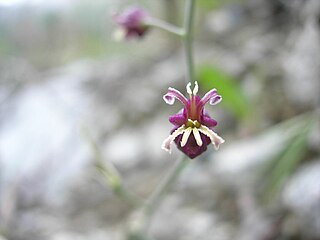
Caulanthus amplexicaulis is a species of flowering plant in the family Brassicaceae known by the common name claspingleaf wild cabbage.
Collinsia greenei is a species of flowering plant in the plantain family known by the common name Greene's blue-eyed Mary.

Cordylanthus nidularius is a rare species of flowering plant in the family Orobanchaceae known by the common name Mt. Diablo bird's beak.

Cordylanthus parviflorus is a species of flowering plant in the family Orobanchaceae known by the common name purple bird's beak. It is native to the western United States where it grows in several types of habitat, including the sagebrush steppe of the Great Basin. It is an annual herb, red-tinted gray-green in color, and hairy, glandular, and sticky in texture. It grows 20 to 60 centimeters tall. The inflorescence bears flowers accompanied by hairy, lobed red-green bracts. The flower is up to 2 centimeters long, made up of a dark-veined pink pouch enveloped in darker sepals.
Lessingia tenuis is a species of flowering plant in the family Asteraceae known by the common name spring lessingia. It is endemic to California, where it is known from the San Francisco Bay Area to Ventura County. It grows on the slopes of the California Coast Ranges in common local habitat such as chaparral.

Orthocarpus cuspidatus is a species of flowering plant in the broomrape family known by the common names Copeland's owl's clover, Siskiyou Mountains orthocarpus, and toothed owl's-clover. It is native to mountain and plateau habitat in Oregon, California, and Nevada. It is an annual herb producing a slender, glandular, hairy, purple-green stem up to about 40 centimeters tall. The narrow leaves are up to 5 centimeters long, the upper ones deeply divided into three linear lobes. The inflorescence is a dense cylindrical spike of wide, oval green bracts with pinkish points. The flowers emerge from between the bracts. Each purple-pink flower is fuzzy in texture and club-shaped, the lower lip an expanded pouch and the upper lip a narrow, straight beak.

Orthocarpus imbricatus is a species of flowering plant in the broomrape family known by the common name mountain owl's-clover. It is native to western North America from British Columbia to northern California, where it grows in meadows and other mountain habitat.

Orthocarpus luteus is a species of flowering plant in the broomrape family known by the common name yellow owl's-clover. It is native to much of western and central North America, where it grows in many types of plateau, grassland, and mountain habitat.
Orthocarpus pachystachyus is a rare species of flowering plant in the broomrape family known by the common names Shasta owl's-clover and Shasta orthocarpus. It is endemic to central Siskiyou County, California, where it is so rarely seen it was thought to be extinct until 1996, when eight individuals were located. The plant grows in an isolated wilderness but since it apparently only occurs on one single hillside it is considered very vulnerable to extinction.
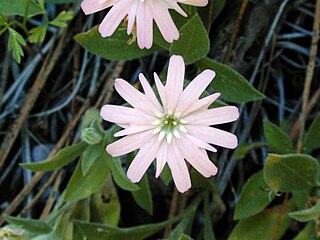
Silene hookeri is a species of flowering plant in the family Caryophyllaceae known by the common names Hooker's silene, Hooker's catchfly, Hooker's Indian pink, and Hooker's glandular campion.

Streptanthus diversifolius is a species of flowering plant in the mustard family known by the common name variableleaf jewelflower, or varied-leaved jewelflower. It is endemic to California, where it is limited to the Sierra Nevada foothills. It is a resident of woodlands and other foothill habitat. It is an annual herb producing a hairless, waxy stem up to a meter tall. The basal leaves are variable in shape and are often divided into narrow, threadlike segments. Leaves higher on the stem are also variable, having round to lance-shaped blades which clasp the stem at their bases. Flowers occur at intervals along the upper stem, with one or two leaflike bracts at the base of the raceme. Each flower has an urn-shaped calyx of keeled sepals about half a centimeter long and white, yellowish, or purple in color, sometimes with white edging. White, purple-veined petals emerge from the tip. The fruit is a thin, flat, curving silique which may be 8 or 9 centimeters in length.
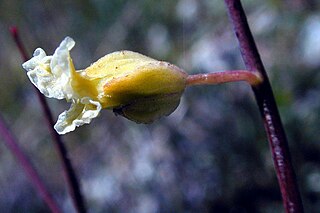
Streptanthus glandulosus is a species of flowering plant in the mustard family known by the common name bristly jewelflower. It is native to California and southwestern Oregon, where it grows in many types of habitat, including grassland, chaparral, and woodlands. Genetic and other analyses indicate that it is a species complex with ten subspecies which evolved as populations were isolated from each other. The complex includes subspecies previously considered separate species, such as the rare Tiburon jewelflower endemic to the San Francisco Bay Area. Plants in the complex are variable. In general they are annual herbs growing 10 centimeters to over a meter in height. They may be hairless hairy to bristly. The ephemeral basal leaves have blades borne on winged petioles. Leaves higher on the stem are linear to lance-shaped and clasp the stem at their bases. Flowers occur at intervals along the upper stem. Each flower has an urn-shaped calyx of sepals one-half to over one centimeter long which can be almost any color from white to yellowish to pink or purple to nearly black. Purple, white, or purple-veined white petals emerge from the tip. The fruit is a straight or curving silique up to 11 centimeters long.

Tricardia is a monotypic genus of flowering plants in the borage family containing the single species Tricardia watsonii, which is known by the common name threehearts. It is native to the southwestern United States, where it grows in deserts and mountains in sandy open habitat, often beneath shrubs. It is a perennial herb growing from a taproot and a woody caudex covered with the shreddy remains of previous seasons' herbage. It produces several erect stems up to about 40 centimeters tall. Most of the leaves are located in a basal rosette about the caudex. They are lance-shaped and coated thinly in woolly hairs. They are up to 9 centimeters long and are borne on petioles. A few smaller leaves occur higher on the stem. Flowers occur in a loose cyme at the top of the stem. Each has a calyx of five sepals. The outer three are heart-shaped and green to pink or purple in color, and the inner two are much smaller and narrower. The flower within is bell-shaped, white with central purple markings, and roughly half a centimeter wide. The fruit is a capsule just under a centimeter long which contains 4 to 8 seeds.
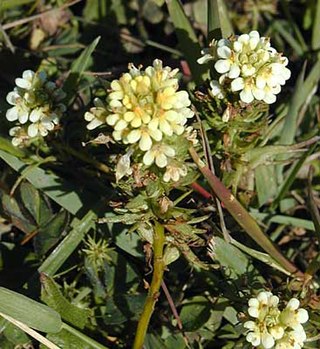
Triphysaria floribunda is a rare species of flowering plant in the family Orobanchaceae known by the common name San Francisco owl's-clover. It is endemic to California, where it is known only from the San Francisco Bay Area. It is limited to coastal regions of Marin, San Francisco, and San Mateo Counties, where it occurs in coastal prairie habitats, sometimes on serpentine soils.
Triphysaria micrantha is a species of flowering plant in the family Orobanchaceae known by the common name purplebeak owl's-clover. It is endemic to California, where it is known from the grasslands of the Central Valley and the foothills to the east and west. It an annual herb producing a hairy, glandular, purple-colored stem up to about 15 centimeters in maximum height. Like many species in its family it is a facultative root parasite on other plants, attaching to their roots via haustoria to tap nutrients. Its greenish to red-purple leaves are up to 2.5 centimeters long and are sometimes divided into a few narrow, pointed lobes. The inflorescence is a spike of flowers a few centimeters in length. Each flower has a narrow purple upper lip and a wide lower lip which is divided into yellowish or white pouches, often with purple markings on the lower parts.

Triphysaria pusilla is a species of flowering plant in the family Orobanchaceae known by the common name dwarf owl's-clover.
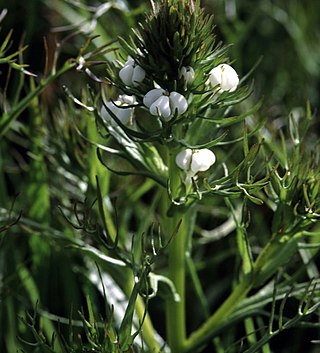
Triphysaria versicolor is a species of flowering plant in the family Orobanchaceae known by the common name yellowbeak owl's-clover.



















